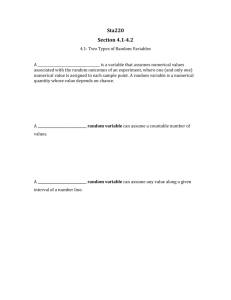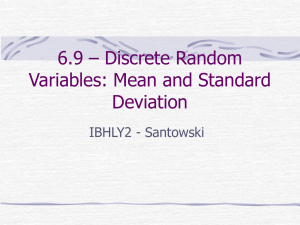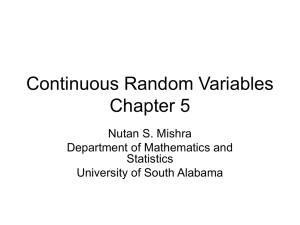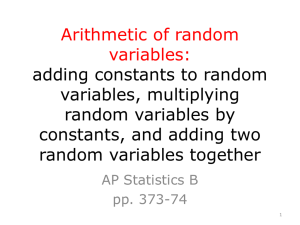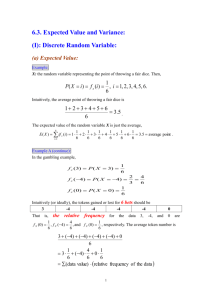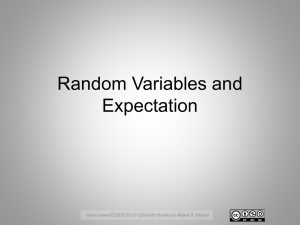Document
advertisement
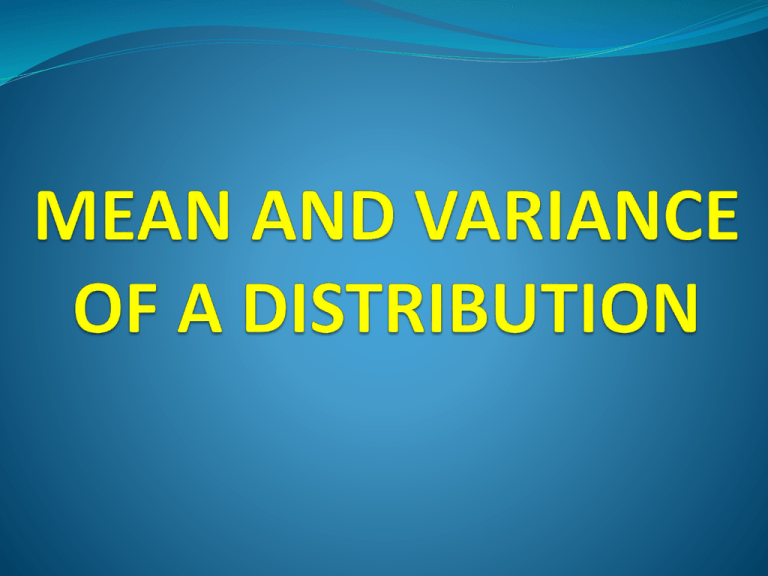
Discrete Uniform Distribution Discrete Uniform Distribution is a probability distribution whereby a finite number of equally spaced values are equally likely to be observed; every one of n values has equal probability 1/n. A simple example of the discrete uniform distribution is fair die. throwing a Continuous Uniform Distribution Continuous Uniform Distribution or Rectangular Distribution is a family of probability distributions such that for each member of the family, all intervals of the same length on the distribution's support are equally probable. Example -Uniform Distribution The uniform distribution: all values are equally likely. f(x)= 1, for 1 x 0 p(x) 1 1 x We can see it’s a probability distribution because it integrates to 1 (the area under the curve is 1): 1 x 1 0 1 1 0 1 0 Example: Uniform Distribution What’s the probability that x is between 0 and ½? p(x) 1 0 ½ P(½ x 0)= ½ 1 x Expected Value and Variance All probability distributions are characterized by an expected value (mean) and a variance (standard deviation squared). Expected value is an extremely useful concept for good decision-making! Example: The Lottery A certain lottery works by picking 6 numbers from 1 to 49. It costs $1.00 to play the lottery, and if you win, you win $2 million. If you play the lottery once, what are your expected winnings or losses? Lottery Calculate the probability of winning in 1 try: “49 choose 6” 1 49 6 1 49 ! 1 7.2 x 10 -8 13 , 983 ,816 43 !6! The probability function (note, sums to 1.0): Out of 49 numbers, this is the number of distinct combinations of 6. x$ p(x) -1 .999999928 + 2 million 7.2 x 10--8 Expected Value The probability function x$ p(x) -1 .999999928 + 2 million 7.2 x 10--8 Expected Value E(X) = P(win)*$2,000,000 + P(lose)*-$1.00 = 2.0 x 106 * 7.2 x 10-8+ .999999928 (-1) = .144 - .999999928 = -$.86 Negative expected value is never good! You shouldn’t play if you expect to lose money! Expected Value If you play the lottery every week for 10 years, what are your expected winnings or losses? Expected Value If you play the lottery every week for 10 years, what are your expected winnings or losses? 520 x (-.86) = -$447.20 Expected Value of a Random Variable Expected value is just the average or mean (µ) of random variable x. It’s sometimes called a “weighted average” because more frequent values of X are weighted more highly in the average. It’s also how we expect X to behave on-average over the long run (“frequentist” view again). Expected Value Discrete Case: E(X ) x i p(x i ) all x Continuous Case: E(X ) x i p(x i )dx all x Symbol Interlude E(X) = µ These symbols are used interchangeably Example: Expected Value Consider the following Probability Distribution: x 10 11 12 13 14 P(x) .4 .2 .2 .1 .1 5 x i 1 i p ( x ) 10 (. 4 ) 11 (. 2 ) 12 (. 2 ) 13 (. 1) 14 (. 1) 11 . 3 Example - Expectation One thousand tickets are sold at $1 each for a colour television valued at $500. What is the Expected Value of gain if a person purchases one ticket ? Example - Expectation One thousand tickets are sold at $1 each for four prizes of $100, $50, $25 and $10. What is the Expected Value of winning a prize if a person purchases two tickets ? Variance/Standard Deviation 2 = Var(x) = E(x-)2 “The expected (or average) squared distance (or deviation) from the mean” Var ( x ) E [( x ) ] 2 2 (x ) i all x 2 p(x i ) Variance Discrete Case: Var ( X ) (x ) p(x i ) 2 i all x Continuous Case: Var ( X ) ( x i ) p(x i )dx all x 2 Symbol Interlude Var(X)= 2 SD(X) = these symbols are used interchangeably Practice Problem It costs $1.00 to play the lottery. The probability of winning the lottery is 18/38 and losing the lottery is 20/38. The mean (already calculated) What’s the variance of X ? is -$.053. Practice Problem 2 (x ) p(x i ) 2 i all x ( 1 . 053 ) (18 / 38 ) ( 1 . 053 ) ( 20 / 38 ) 2 2 (1 . 053 ) (18 / 38 ) ( 1 . 053 ) ( 20 / 38 ) 2 2 (1 . 053 ) (18 / 38 ) ( . 947 ) ( 20 / 38 ) 2 2 . 997 . 997 . 99 Standard deviation is $.99. Interpretation: On average, you’re either 1 dollar above or 1 dollar below the mean, which is just under zero. Makes sense! Theorem The variance of a random variable X is б2 = E(X2) - µ2 OR б2 = E(X2) – [E(X)]2 Example Let the random variable X represent the number of defective parts for a machine when 3 parts are sampled from a production line and tested. Calculate Variance of the following Probability Distribution of X. x f(x) 0 0.51 1 0.38 2 0.10 3 0.01 Problem 1 Find the mean and the variance of the random variable X with probability function or density f(x): f(x) = 2x, (0 ≤ x ≤ 1) Problem 3 Find the mean and the variance of the random variable X with probability function f(x): X = Number a fair die turns up Problem 5 Find the mean and the variance of the random variable X with probability function or density f(x): Uniform distribution on [ 0, 8 ] Uniform Distribution f(x) = 1/b-a 0 F(x) = x-a/b-a 0 a≤x≤b Otherwise a≤x≤b Otherwise Problem 7 What is the expected daily profit, if a store sells X air conditioners per day with probability f(10) = 0.1, f(11) = 0.3, f(12) = 0.4, f(13) = 0.2, and profit per air conditioner is $55 ? Problem 9 If the mileage (in multiples of 1000 miles) after which a tyre must be replaced is given by the random variable X with density f(x) = θ e-θx (x > 0). What mileage can you expect to get on one of these tyres? Also find the probability that a tyre will last at least 40,000 miles. Problem 11 A small filling station is supplied with gasoline every Saturday afternoon. Assume that its volume X of sales in ten thousands of gallons has the probability density f(x) = 6x ( 1 – x ), if 0 ≤ x ≤ 1 and 0 otherwise. Determine the mean, variance and the standardized variable. Standardized Random Variable Z=X-µ б Std Rand Variable = X - Mean Std Deviation Problem 13 Let X [cm] be the diameter of bolts in a production. Assume that X has the density f(x) = k ( x – 0.9 ) ( 1.1 – x ) if 0.9 < x < 1.1 and 0 otherwise. Determine k, sketch f(x), and find µ and б2. ASSIGNMENT NO 1 Briefly describe following with the help of examples: Role of Probability Relation between Probability and Statistical Inference Random Sampling Bayes’ Rule Joint Probability Distribution Hand Written assignments be submitted by 15 Nov 2012. Copying and Late Submissions will have appropriate penalty.
